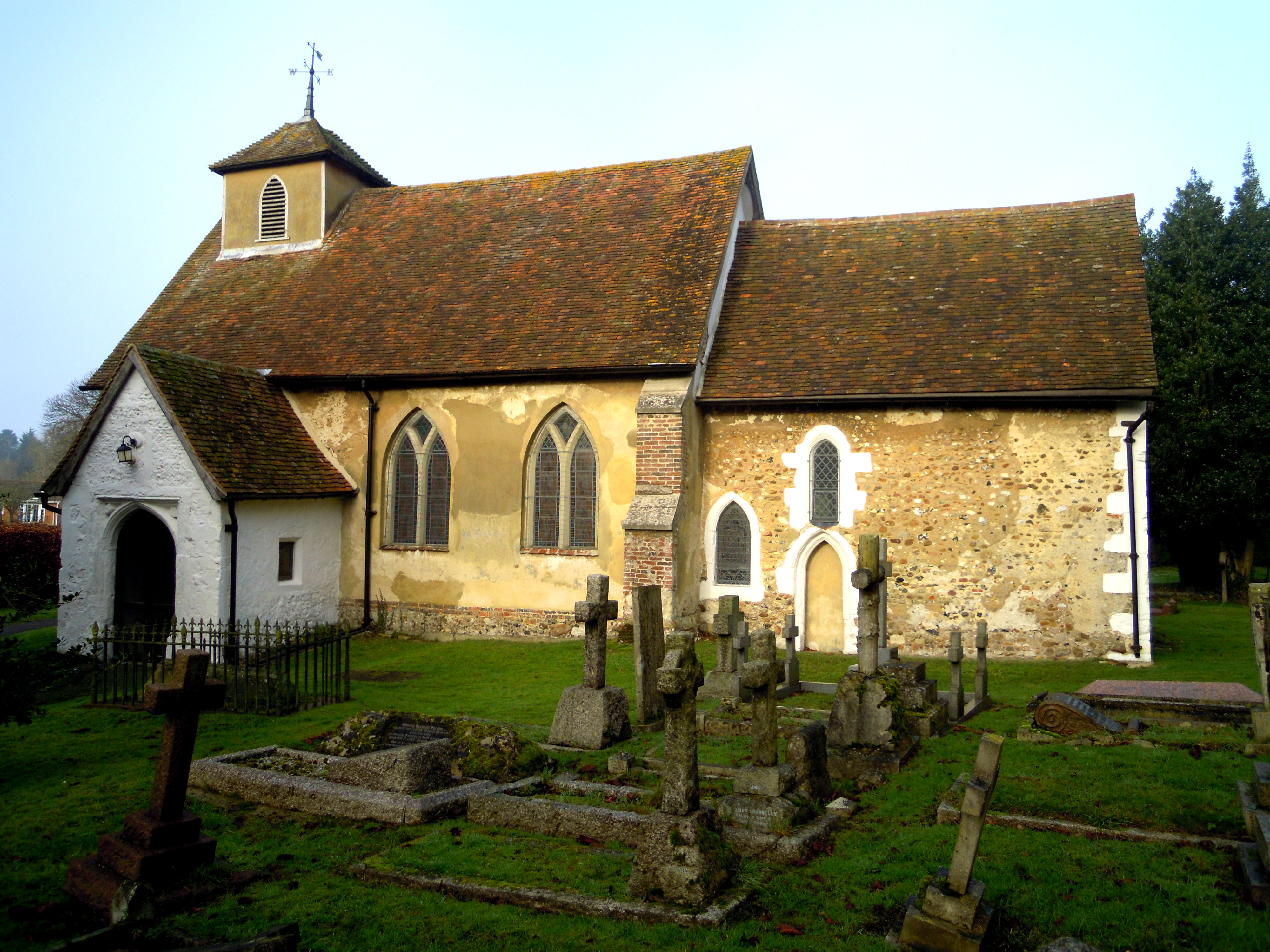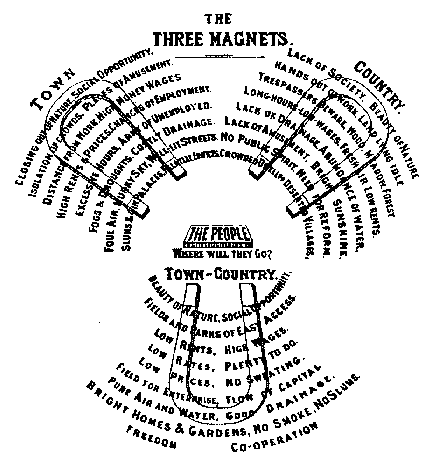|
Broadway, Letchworth
Broadway is a road through the centre of Letchworth, in Hertfordshire, England, laid out when the garden city of Letchworth was created. It incorporates Broadway Gardens, and is listed Grade II in Historic England's Register of Parks and Gardens. History Ebenezer Howard pioneered the idea of creating garden cities; they would benefit the whole community, they would be well planned and integrate the best aspects of town and country. The first garden city was Letchworth, on a site acquired in 1903. It was planned in 1904 by the architects Barry Parker and Raymond Unwin. This included a broad spinal approach road from the south and north, named Broadway, leading to Town Square, where the principle buildings of the town would be erected. Lombardy poplars were planted about 1914 to show the location of the buildings, which in the course of events were never built. The section from Hitchin Road northwards to the roundabout was the first part of Broadway to be constructed, about 1 ... [...More Info...] [...Related Items...] OR: [Wikipedia] [Google] [Baidu] |
Letchworth
Letchworth Garden City, commonly known as Letchworth, is a town in the North Hertfordshire district of Hertfordshire, England. It is noted for being the first garden city. The population at the time of the 2011 census was 33,249. Letchworth was an ancient parish, appearing in the Domesday Book of 1086. It remained a small rural village until the start of the twentieth century. The development of the modern town began in 1903, when much of the land in Letchworth and the neighbouring parishes of Willian and Norton was purchased by a company called First Garden City Limited, founded by Ebenezer Howard and his supporters with the aim of building the first "garden city", following the principles Howard had set out in his 1898 book, ''To-morrow: A Peaceful Path to Real Reform''. Their aim was to create a new type of settlement which provided jobs, services, and good housing for residents, whilst retaining the environmental quality of the countryside, in contrast to most indust ... [...More Info...] [...Related Items...] OR: [Wikipedia] [Google] [Baidu] |
Hertfordshire
Hertfordshire ( or ; often abbreviated Herts) is one of the home counties in southern England. It borders Bedfordshire and Cambridgeshire to the north, Essex to the east, Greater London to the south, and Buckinghamshire to the west. For government statistical purposes, it forms part of the East of England region. Hertfordshire covers . It derives its name – via the name of the county town of Hertford – from a Hart (deer), hart (stag) and a Ford (crossing), ford, as represented on the county's coat of arms and on the Flag of Hertfordshire, flag. Hertfordshire County Council is based in Hertford, once the main market town and the current county town. The largest settlement is Watford. Since 1903 Letchworth has served as the prototype Garden city movement, garden city; Stevenage became the first town to expand under post-war Britain's New Towns Act 1946, New Towns Act of 1946. In 2013 Hertfordshire had a population of about 1,140,700, with Hemel Hempstead, Stevenage, Watford ... [...More Info...] [...Related Items...] OR: [Wikipedia] [Google] [Baidu] |
Garden City Movement
The garden city movement was a 20th century urban planning movement promoting satellite communities surrounding the central city and separated with greenbelts. These Garden Cities would contain proportionate areas of residences, industry, and agriculture. Ebenezer Howard first posited the idea in 1898 as a way to capture the primary benefits of the countryside and the city while avoiding the disadvantages presented by both. In the early 20th century, Letchworth, Brentham Garden Suburb and Welwyn Garden City were built in or near London according to Howard's concept and many other garden cities inspired by his model have since been built all over the world. History Conception Inspired by the utopian novel '' Looking Backward'' and Henry George's work '' Progress and Poverty'', Howard published the book '': a Peaceful Path to Real Reform'' in 1898 (which was reissued in 1902 as '' Garden Cities of To-morrow''). His idealised garden city would house 32,000 people on a s ... [...More Info...] [...Related Items...] OR: [Wikipedia] [Google] [Baidu] |
Historic England
Historic England (officially the Historic Buildings and Monuments Commission for England) is an executive non-departmental public body of the British Government sponsored by the Department for Digital, Culture, Media and Sport. It is tasked with protecting the historic environment of England by preserving and listing historic buildings, scheduling ancient monuments, registering historic Parks and Gardens and by advising central and local government. The body was officially created by the National Heritage Act 1983, and operated from April 1984 to April 2015 under the name of English Heritage. In 2015, following the changes to English Heritage's structure that moved the protection of the National Heritage Collection into the voluntary sector in the English Heritage Trust, the body that remained was rebranded as Historic England. The body also inherited the Historic England Archive from the old English Heritage, and projects linked to the archive such as Britain from Above ... [...More Info...] [...Related Items...] OR: [Wikipedia] [Google] [Baidu] |
Register Of Parks And Gardens
The Register of Historic Parks and Gardens of Special Historic Interest in England provides a listing and classification system for historic parks and gardens similar to that used for listed buildings. The register is managed by Historic England under the provisions of the National Heritage Act 1983. Over 1,600 sites are listed, ranging from the grounds of large stately homes to small domestic gardens, as well other designed landscapes such as town squares, public parks and cemeteries.Registered Parks & Gardens page on . Retrieved 23 December 2010. Purpose The register aims to "celebrate designed landscap ...[...More Info...] [...Related Items...] OR: [Wikipedia] [Google] [Baidu] |
Ebenezer Howard
Sir Ebenezer Howard (29 January 1850 – 1 May 1928) was an English urban planner and founder of the garden city movement, known for his publication '' To-Morrow: A Peaceful Path to Real Reform'' (1898), the description of a utopian city in which people live harmoniously together with nature. The publication resulted in the founding of the garden city movement, and the building of the first garden city, Letchworth Garden City, commenced in 1903. The second true Garden City was Welwyn Garden City (1920) and the movement influenced the development of several model suburbs in other countries, such as Forest Hills Gardens designed by F. L. Olmsted Jr. in 1909, Radburn NJ (1923), Pinelands, Cape Town and the Suburban Resettlement Program towns of the 1930s ( Greenbelt, Maryland; Greenhills, Ohio; Greenbrook, New Jersey and Greendale, Wisconsin). Howard aimed to reduce the alienation of humans and society from nature, and hence advocated garden citiesClark, B 2003'Ebenezer H ... [...More Info...] [...Related Items...] OR: [Wikipedia] [Google] [Baidu] |
Richard Barry Parker
Richard Barry Parker (18 November 1867 – 21 February 1947) was an English architect and urban planner associated with the Arts and Crafts Movement. He was primarily known for his architectural partnership with Raymond Unwin. Biography Parker was born in Chesterfield in 1867, the son of bank manager Robert Parker. He trained at T.C. Simmonds Atelier of Art in Derby and the studio of George Faulkner Armitage in Altrincham. In 1891 he joined his father in Buxton and designed three large houses for him there. In 1896 Parker went into partnership with Raymond Unwin, who was Parker's half cousin as well as his brother-in-law, having married his sister Ethel in 1893. One of their earliest commissions was to design and build a large family home on farming land in Clayton Staffordshire, for a local manufacturer of pottery, Charles Frederick Goodfellow. Finished in 1899 the house gave them the opportunity to incorporate many internal and external features including an open, gal ... [...More Info...] [...Related Items...] OR: [Wikipedia] [Google] [Baidu] |
Raymond Unwin
Sir Raymond Unwin (2 November 1863 – 29 June 1940) was a prominent and influential English engineer, architect and town planner, with an emphasis on improvements in working class housing. Early years Raymond Unwin was born in Rotherham, Yorkshire and grew up in Oxford, after his father sold up his business and moved there to study. He was educated at Magdalen College School, Oxford. In 1884 he become an apprentice engineer for Stavely Iron & Coal Company near Chesterfield. Unwin had become interested in social issues at an early age and was inspired by the lectures and ideals of John Ruskin and William Morris. In 1885 he moved to Manchester and became secretary of Morris's local Socialist League. He wrote articles for the League's newspaper and spoke on street corners for its cause and for the Labour Church. He also became a close friend of the socialist philosopher Edward Carpenter, whose Utopian community ideas led to his developing a small commune at Millthorpe near Sh ... [...More Info...] [...Related Items...] OR: [Wikipedia] [Google] [Baidu] |
Lombardy Poplar
''Populus nigra'', the black poplar, is a species of cottonwood poplar, the type species of section ''Aigeiros'' of the genus ''Populus'', native to Europe, southwest and central Asia, and northwest Africa.Flora Europaea''Populus nigra''/ref> Description Black poplars are medium- to large-sized deciduous trees, reaching 20–30 m, and rarely 40 m tall. Their leaves are diamond-shaped to triangular, 5–8 cm long and 6–8 cm broad, and green on both surfaces.Rushforth, K. (1999). ''Trees of Britain and Europe''. Collins. . Normally, their trunks achieve up to 1.5 m in diameter, but some unusual individual trees in France have grown old enough to have much larger trunks – more than 3 metres DBH ( Diameter at Breast Height). The species is dioecious (male and female flowers are on different plants), with flowers in catkins and pollination achieved by the wind. The black poplar grows in low-lying areas of moist ground. Like most other pioneer species, the ... [...More Info...] [...Related Items...] OR: [Wikipedia] [Google] [Baidu] |
Roundabout
A roundabout is a type of circular intersection or junction in which road traffic is permitted to flow in one direction around a central island, and priority is typically given to traffic already in the junction.''The New Shorter Oxford English Dictionary,'' Volume 2, Clarendon Press, Oxford (1993), page 2632 Engineers use the term modern roundabout to refer to junctions installed after 1960 that incorporate various design rules to increase safety. Both modern and non-modern roundabouts, however, may bear street names or be identified colloquially by local names such as rotary or traffic circle. Compared to stop signs, traffic signals, and earlier forms of roundabouts, modern roundabouts reduce the likelihood and severity of collisions greatly by reducing traffic speeds and minimizing T-bone and head-on collisions. Variations on the basic concept include integration with tram or train lines, two-way flow, higher speeds and many others. For pedestrians, traffic exiting t ... [...More Info...] [...Related Items...] OR: [Wikipedia] [Google] [Baidu] |
Howard Park And Gardens
Howard Park and Gardens is a public recreation ground in Letchworth, in Hertfordshire, England, laid out when the garden city of Letchworth was created. It is listed Grade II in Historic England's Register of Parks and Gardens. History The park and gardens are named after Ebenezer Howard, who pioneered the idea of creating garden cities; they would benefit the whole community, they would be well planned and integrate the best aspects of town and country. The first garden city was Letchworth, on a site acquired in 1903. It was planned in 1904 by the architects Barry Parker and Raymond Unwin; it included a corridor of green space, which became the park and gardens, within a residential area. It was laid out from 1904 to 1911. Description The area is about . Howard Park, to the north, and Howard Gardens, to the south, are divided by Hillshott Road. Norton Way South is on the western border. The more informal Park has a large green space, a play area, a paddling pool opened in 1930 ... [...More Info...] [...Related Items...] OR: [Wikipedia] [Google] [Baidu] |
A505 Road
The A505 is an A-class road in England. It follows part of the route of the Icknield Way and the corresponding Icknield Way Path and runs from Leighton Buzzard in Bedfordshire to the A11 Abington Interchange North in Cambridgeshire. Route Bedfordshire – Leighton Buzzard to Luton The road begins at a roundabout with the A418, the A4146 and the B440 south of Leighton Buzzard as a wide A-Class Primary Route. The road passes through two roundabouts as a single carriageway, and acts as the Leighton Buzzard Bypass. To enter Leighton Buzzard from the A505, an advisable route is to use the A4012 North from the roundabout at Billington. Southbound on the B440 from here will take you towards Hemel Hempstead and Whipsnade Zoo. Continue along the A505 along a 50 MPH stretch with speed cameras to reach the A5 at a roundabout, where the A5 (in the form of a spur) replaces its existing eastbound route to form the Dunstable Northern Bypass to M1 Junction 11a. Going northbound on the m ... [...More Info...] [...Related Items...] OR: [Wikipedia] [Google] [Baidu] |




.jpg)

